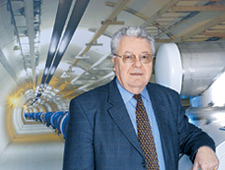Commentary: Robert Aymar
 |
|
Photo: CERN |
Basic science in a competitive world
We are constantly being told that we live in a competitive world in which innovation is the main driver towards growth and prosperity. What is the place in such a world for fundamental science, whose short-term contribution to society is knowledge without any immediate application? Is it an unnecessary luxury? Should the world be deploying its resources in pursuit of more pressing needs: public health, clean energy, safe water? Of course it should, and I believe that investment in fundamental science serves these goals. It is a long-term investment, laying the foundations for future innovation and prosperity.
History teaches us that big jumps in human innovation come about mainly as a basic result of pure curiosity. Innovation is key to meeting many of today's development challenges, and the primary force for innovation is fundamental research. Without it, there would be no science to apply. Faraday's experiments on electricity, for example, were driven by curiosity but eventually brought us electric light. No amount of R&D on the candle could ever have done that. Electric light came from innovation driven by fundamental science.
The long-term role of fundamental science is well understood by the European Investment Bank, the financial arm of the European Union. In 2003, the EIB gave a strong endorsement of fundamental science when it lent €300 million to CERN to help finance the construction of the Large Hadron Collider (LHC). Why should the EIB consider the world's largest fundamental physics project to be a worthy investment? I believe the reason is that fundamental science paves the way to future innovation.
Fundamental research has the power to make people dream, and it attracts the innovators of the future into science. Without the excitement provided by research and discovery at the frontiers of knowledge, the pool of scientists would undoubtedly be smaller.
The scientists who work on the LHC are driven by a desire to learn about the universe, but that has not stopped them from developing particle acceleration and detection techniques that have found applications in medicine, for example. Scientists at CERN invented the World Wide Web, which has revolutionized the way we share information and do business. Today the LHC community worldwide is working on computing grids, the next frontier in information technology, which already have applications in fields such as Earth observation, climate prediction, petroleum exploration, and drug discovery.
LHC experiments will observe particle collisions at the rate of up to 600 million per second. This equates to about one petabyte per second, roughly the equivalent of about 150,000 DVD movies. Clearly, storing such quantities would be impossible, so we have to develop very clever electronics to sift out the interesting data. Even after draconian data reduction, however, we will be storing around 15 petabytes per year. Organizing access to this data for thousands of scientists from around the world is the reason particle physics is at the forefront of grid computing, which will make access to computing resources as simple as tapping into the electricity grid by plugging in an electric light.
Fundamental science has a vital role to play in today's competitive world. It is fundamental science that lays the long-term foundations for innovation and prosperity. Abdus Salam, the Nobel prize-winning physicist from Pakistan, said, "In the final analysis, creation, mastery, and utilization of modern science and technology [are] basically what distinguishes the South from North. On science and technology depend the standards of living of a nation." This is the challenge for fundamental science in today's world of competition. Fundamental science has a vital role to play in the process of innovation. In today's competitive world, it is as important as it has ever been.
Robert Aymar is director-general of CERN, the European particle physics laboratory in Geneva, Switzerland, for the 2004–2008 term. He was previously director of the International Thermonuclear Experimental Reactor (ITER).
Click here to download the pdf version of this article.


